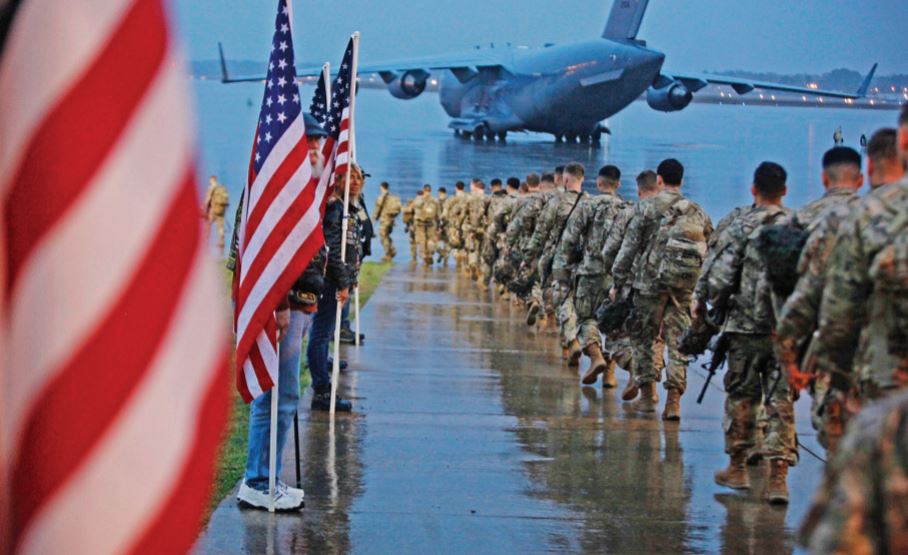Severe Humanitarian Disasters Caused by US Aggressive Wars against Foreign Countries


The China Society for Human Rights Studies on Friday released an article titled "Severe Humanitarian Disasters Caused by US Aggressive Wars against Foreign Countries." Full text below:
The United States has always praised itself as "a city upon a hill" that is an example to others in the way it supports "natural human rights" and fulfills "natural responsibilities", and it has repeatedly waged foreign wars under the banner of "humanitarian intervention". During the past 240-plus years after it declared independence on July 4th, 1776, the United States was not involved in any war for merely less than 20 years. According to incomplete statistics, from the end of World War II in 1945 to 2001, among the 248 armed conflicts that occurred in 153 regions of the world, 201 were initiated by the United States, accounting for 81 percent of the total number. Most of the wars of aggression waged by the United States have been unilateralist actions, and some of these wars were even opposed by its own allies. These wars not only cost the belligerent parties a large number of military lives but also caused extremely serious civilian casualties and property damage, leading to horrific humanitarian disasters. The selfishness and hypocrisy of the United States have also been fully exposed through these foreign wars.
1. Major Aggressive Wars Waged by the United States after World War II
(1) The Korean War. The Korean War, which took place in the early 1950s, did not persist for a long time but it was extremely bloody, leading to more than three million civilian deaths and creating more than three million refugees. According to statistics from the DPRK, the war destroyed about 8,700 factories, 5,000 schools, 1,000 hospitals, and 600,000 households, and more than two million children under the age of 18 were uprooted by the war. During this war, the ROK side lost 41.23 billion won, which was equivalent to 6.9 billion US dollars according to the official exchange rate at that time; and about 600,000 houses, 46.9 percent of railways, 1,656 highways, and 1,453 bridges in the ROK were destroyed. Worse still, the war led to the division of the DPRK and the ROK, causing a large number of family separations. Among the more than 130,000 Koreans registered in the Ministry of Unification in the ROK who have family members cut off by the war, 75,000 have passed away, forever losing the chance to meet their lost family members again. The website of the United States' The Diplomat magazine reported on June 25, 2020, that as of November 2019, the average age of these family separation victims in the ROK had reached 81, and 60 percent of the 133,370 victims registered since 1988 had passed away, and that most of the registered victims never succeeded in meeting their lost family members again.
(2) The Vietnam War. The Vietnam War which lasted from the 1950s to the 1970s is the longest and most brutal war since the end of World War II. The Vietnamese government estimated that the war killed approximately 1.1 million North Vietnamese soldiers and 300,000 South Vietnamese soldiers, and caused as many as two million civilian deaths. The government also pointed out that some of the deaths were caused by the US troops' planned massacres that were carried out in the name of "combating the Vietnamese Communist Party". During the war, the US forces dropped a large number of bombs in Vietnam, Laos, and Cambodia, almost three times the total number of bombs dropped during World War II. It is estimated that as of today, there are at least 350,000 metric tons of unexploded mines and bombs left by the US military in Vietnam alone, and these mines and bombs are still explosive. At the current rate, it will take 300 years to clean out these explosives. The website of The Huffington Post reported on December 3, 2012, that statistics from the Vietnamese government showed that since the end of the war in 1975, the explosive remnants of the war had killed more than 42,000 people. Apart from the above-mentioned explosives, the US forces dropped 20 million gallons (about 75.71 million liters) of defoliants in Vietnam during the war, directly causing more than 400,000 Vietnamese deaths. Another approximately two million Vietnamese who came into contact with this chemical got cancer and other diseases. This war that lasted for more than 10 years also caused more than three million refugees to flee and die in large numbers on the way across the ocean. Among the refugees that were surveyed, 92 percent were troubled by fatigue, and others suffered unexplained pregnancy losses and birth defects. According to the United States' Vietnam War statistics, defoliants destroyed about 20 percent of the jungles and 20 to 36 percent of the mangrove forests in Vietnam.
(3) The Gulf War. In 1991, the US-led coalition forces attacked Iraq, directly leading to about 2,500 to 3,500 civilian deaths and destroying approximately 9,000 civilian houses. The war-inflicted famine and damage to the local infrastructure and medical facilities caused about 111,000 civilian deaths, and the United Nations Children's Fund (UNICEF) estimated that the war and the post-war sanctions on Iraq caused the death of about 500,000 of the country's children. The coalition forces targeted Iraq's infrastructure and wantonly destroyed most of its power stations (accounting for 92 percent of the country's total installed generating capacity), refineries (accounting for 80 percent of the country's production capacity), petrochemical complexes, telecommunication centers (including 135 telephone networks), bridges (numbering more than 100), highways, railways, radio and television stations, cement plants, and factories producing aluminum, textiles, wires, and medical supplies. This war led to serious environmental pollution: about 60 million barrels of petroleum were dumped into the desert, polluting about 40 million metric tons of soil; about 24 million barrels of petroleum spilled out of oil wells, forming 246 oil lakes; and the smoke and dust generated by purposely ignited oil wells polluted 953 square kilometers of land. In addition, the US troops' depleted uranium (DU) weapons, which contain highly toxic and radioactive material, were also first used on the battlefield during this Gulf War against Iraq.
(4) The Kosovo War. In March 1999, NATO troops led by the United States blatantly set the UN Security Council aside and carried out a 78-day continuous bombing of Yugoslavia under the banner of "preventing humanitarian disasters", killing 2,000-plus innocent civilians, injuring more than 6,000, and uprooting nearly one million. During the war, more than two million Yugoslavians lost their sources of income, and about 1.5 million children could not go to school. NATO troops deliberately targeted the infrastructure of Yugoslavia in order to weaken the country's determination to resist. Economists of Serbia estimated that the total economic loss caused by the bombing was as much as 29.6 billion US dollars. Lots of bridges, roads, railways, and other buildings were destroyed during the bombing, affecting 25,000 households, 176 cultural relics, 69 schools, 19 hospitals, and 20 health centers. Apart from that, during this war, NATO troops used at least 31,000 DU bombs and shells, leading to a surge in cancer and leukemia cases in Yugoslavia and inflicting a long-term disastrous impact on the ecological environment of Yugoslavia and Europe.
(5) The Afghanistan War. In October 2001, the United States sent troops to Afghanistan. While combating al-Qaeda and the Taliban, it also caused a large number of unnecessary civilian casualties. Due to the lack of authoritative statistical data, there is no established opinion about the number of civilian casualties during the Afghanistan War, but it is generally agreed that since entering Afghanistan, the US troops caused the deaths of more than 30,000 civilians, injured more than 60,000 civilians, and created about 11 million refugees. After the US military announced its withdrawal in 2014, Afghanistan continued to be in turmoil. The website of The New York Times reported on July 30, 2019, that in the first half of 2019, there were 363 confirmed deaths due to the US bombs in Afghanistan, including 89 children. Scholars at Kabul University estimated that since its beginning, the Afghanistan War has caused about 250 casualties and the loss of 60 million US dollars per day.
(6) The Iraq War. In 2003, despite the general opposition of the international community, US troops still invaded Iraq on unfounded charges. It is hard to find precise statistics about the civilian casualties inflicted by the war, but the number is estimated to be around 200,000 to 250,000, including 16,000 civilian deaths directly caused by US forces. Apart from that, the occupying US forces have seriously violated international humanitarian principles and created multiple "prisoner abuse cases". After the US military announced its withdrawal from Iraq in 2011, local warfare and attacks in the country have continued. The US-led coalition forces have used a large number of DU bombs and shells, cluster bombs, and white phosphorus bombs in Iraq, and have not taken any measures to minimize the damage these bombs have inflicted upon civilians. According to the estimate of the United Nations, today in Iraq, there are still 25 million mines and other explosive remnants that need to be removed. The United States has not yet withdrawn all its troops from Afghanistan or Iraq for now.
(7) The Syrian War. Since 2017, the United States has launched airstrikes on Syria under the pretext of "preventing the use of chemical weapons by the Syrian government". From 2016 to 2019, the confirmed war-related civilian deaths amounted to 33,584 in Syria, and the number of Syrian civilians directly killed by the airstrikes reached 3,833, with half of them being women and children. The website of the Public Broadcasting Service (PBS) reported on November 9, 2018, that the so-called "most accurate air strike in history" launched by the United States on Raqqa killed 1,600 civilians. According to a survey conducted by the World Food Programme (WFP) in April 2020, about one-third of Syrians were faced with a food shortage crisis, and 87 percent of Syrians had no deposits in their accounts. Doctors of the World (Médecins du Monde/MdM) estimated that since the beginning of the Syrian War, about 15,000 Syrian doctors (about half of the country's total) had fled the country, 6.5 million Syrian people had run away from their homes, and about five million Syrian people had wandered homeless around the world.
Apart from being directly involved in wars, the United States has intervened directly or indirectly in other countries' affairs by supporting proxy wars, inciting anti-government insurgencies, carrying out assassinations, providing weapons and ammunition, and training anti-government armed forces, which have caused serious harm to the social stability and public security of the relevant countries. As such activities are great in number and most of them have not been made public, it is hard to collect specific data regarding them.


































